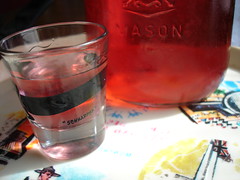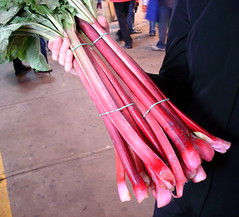Nectar of the Gods
 fig. 1: pink rhubarb schnapps and "Schnappsy" the wiener dog-bearing shot glass
fig. 1: pink rhubarb schnapps and "Schnappsy" the wiener dog-bearing shot glass
Pink lemonade? Pink Lady mix? Pink lightning? No, no, and no. This lovely elixir is none other than rhubarb schnapps--homemade rhubarb schnapps, that is. The verdict is still out on rhubarb schnapps' health benefits, but seeing as rhubarb spent most of its history being championed for its medicinal qualities, we're optimistic. Rhubarb was known in classical Greece and Rome when it was known to flourish in Asia Minor and points east, and, in fact, it appears as though wild rhubarb is native to parts of Mongolia, Siberia, and the region surrounding the Himalayas. Consequently, it was recognized by Chinese herbalists in ancient times, although just how far back is disputed amongst scholars. The perception that rhubarb is a medicinal green remained prevalent for thousands of years, until well into the 19th century. Rhubarb may have been cooked and eaten sometime earlier, largely because of its resemblance to sorrel, but it was only in the 19th century that cookbooks in England began to include recipes using rhubarb, most if not all of them in a sweet vein. By the mid-19th century rhubarb was quite firmly established as staple ingredient in the making of sweet preserves such as compotes and jams, as well as in sweet pies and tarts. From a botanical standpoint, rhubarb is a vegetable--a leafy green with edible stalks--but its identity became tied to the way it was now typically eaten, and in 1947 US Customs Court in Buffalo made things official (as Customs Courts are wont to do), declaring rhubarb to be a fruit.
Personally, we're glad. Non-fruit-based schnapps are hardly unheard of--take kümmel, the caraway seed-flavored schnapps, for instance--but we'd feel a little silly about making a schnapps that was pink and savory. (Now, if it was baby blue, on the other hand...) Like many of you out there, we're big, big fans of rhubarb as a compote and a jam, not to mention in pies, tarts, and crumbles of all sorts, but if you've got a lot of extra rhubarb in your garden and you're not sure how to use it all*, or you want to make something striking and different with that beautiful pink rhubarb that you can find in the markets at this time of year rhubarb schnapps is the answer.  fig. 2: pink rhubarb at Jean-Talon Market
fig. 2: pink rhubarb at Jean-Talon Market
Of course, you can make rhubarb schnapps with green rhubarb too, and it tastes just as good, but it just won't look quite so purty in those big old mason jars.
To make rhubarb schnapps*:
enough chopped rhubarb to fill a one-litre jar 3/4 full
150 g granulated sugar
+/- 500 ml vodka
Wash, drain, and then chop the rhubarb. Put it in a one-litre jar, add sugar, then top with vodka. Let sit for 1-6 months, shaking the jar from time to time. Strain and re-bottle. Keeps for a long time. Makes people happy.
Prost!
am/km
* My cousins Paul and Bobby were thrilled to learn how to make rhubarb schnapps from us a few years ago, because they had rhubarb "coming out of their ears." They'd transplanted some of my grandfather's "heirloom" rhubarb when they moved into their respective houses on the Quebec/New Brunswick border years earlier and the rhubarb had since taken over their gardens. They'd give bushels to anyone who wanted any and they were desperate to find ways to prepare rhubarb other than just compote and pies.--aj
** This recipe comes from Nigella Lawson's How To Be a Domestic Goddess. It was this recipe, in fact, that convinced me I had to have that book.--m








No comments:
Post a Comment